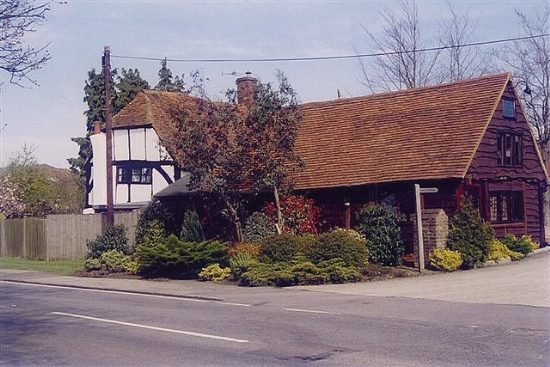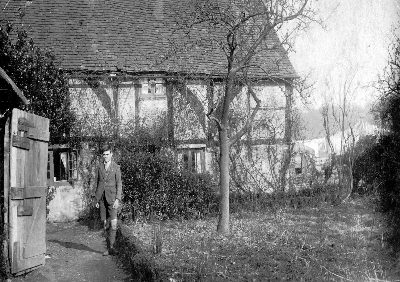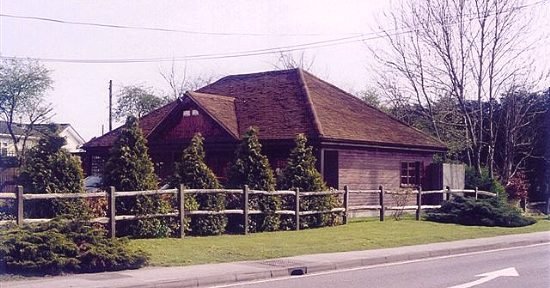Chapel Farm Cottage

- Chapel Farm Cottage
Chapel Farm Cottage lies on the east side of Aldershot Road about 200
yards on the Guildford side of the sharp bend in the road at Willey Green.
It is a timber framed building and was originally an open hall house of
four bays built on a foundation of heath stone and dating from the early
16th century. Probably early in the 17th century an upper floor was inserted
across the hall to provide a continuous first floor over the whole house
and a brick chimney stack was constructed for a large hearth and ingle
nook fireplace containing a bread oven in the main ground floor room. The
easternmost bay was replaced by a single storey flat roofed kitchen in
the mid 20th century. The spaces between the timbers are nogged with a
variety of bricks including some early narrow ones. This probably replaces
wattle and daub infilling. Some wattle and daub still exists in the partition
wall of one of the upper rooms. The pitched roof has queen posts and tie
beams with a single clasped purlin on each side. There are also wind braces.
There is a half hip at the west end and the roof is covered with clay tiles.
The holding, for which the cottage was the farmhouse, had its origin
in a plot of land called Heathers granted to King Edward III in 1352 by
John and Joan Fletcher, Philip of Beckford, Julian his wife and her sister.
In the same year the King exchanged Heathers for a toft inside Henley Park
with John Aynolf. It was described in the Cleygate Manor records as "a
freehold tenement and a freehold croft and meadow lying to the east of
the park of Henley".
The property was subsequently acquired by the Bedell Family and by 1607
was described as Heathers alias Beadles alias Hettricks. The property descended
through various owners and in 1922 was purchased by Charles Hellard a retired
Captain of Army, and the farm was retitled Chapel Farm in reference to
the nearby Congregational Chapel built in 1825. They kept pigs until June
1926 when swine fever struck and they lost their livelihood. The farm,
then a small holding of 5 acres, was sold in 1936 to the Baylisses, timber
merchants from West End, Woking
 |
Chapel Farm Cottage with Charb (Charles) Hellard in 1927 |
In 1938 William Bayliss was dealing in second hand cars and during the
war they broke up vehicles for scrap metal. In 1965 they started Normandy
Auto Salvage which recovered and sold spare parts for cars. In 1966 a wood
yard was started and they were offering garden sheds and fencing for sale.
In 1981 this was extended to include Wendy Houses, loose boxes and summerhouses.
Behind the cottage the ground was developed as a mobile home park, started
when in the 1950s a converted London tram was towed to the site. The wood
yard closed in 1993 and an egg farm was set up followed in 1994 by the
opening of a farm shop. This closed in 1998.

- Chapel Farm farm shop
By this time the Chapel Farm Cottage property had been reduced to a
small plot surrounding the cottage together with a small barn. The cottage
had been neglected and was falling into such a state of decay that demolition
was considered but in 2006 Justin Mortimer bought the property and decided
to carry out a thorough renovation and partial rebuilding programme. After
a battle with Guildford Borough Council Planning Department permission
was granted to carry out the work.
At the time of writing considerable progress has been made including
the replacement of the flat-roofed extension by a two-storied cross wing
in a style in keeping with the original structure. All the work is to the
highest standard but much remains to be done. The completion of the work
will result in the saving of a listed building of charming aspect that
will enhance the appearance of this part of the village.
I am indebted to the researches of John Squier for most of the information
contained in this article.
Jack Kinder |